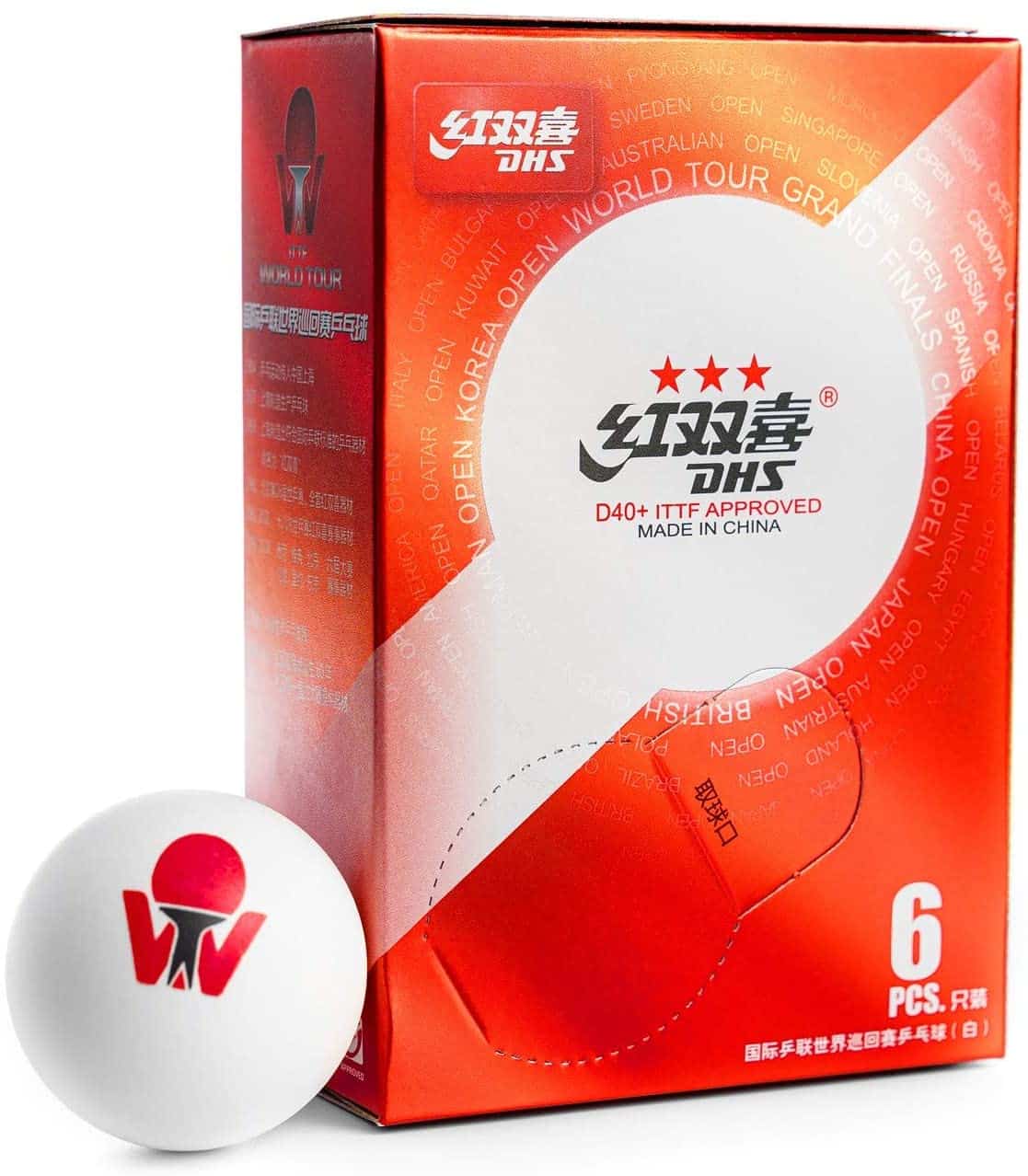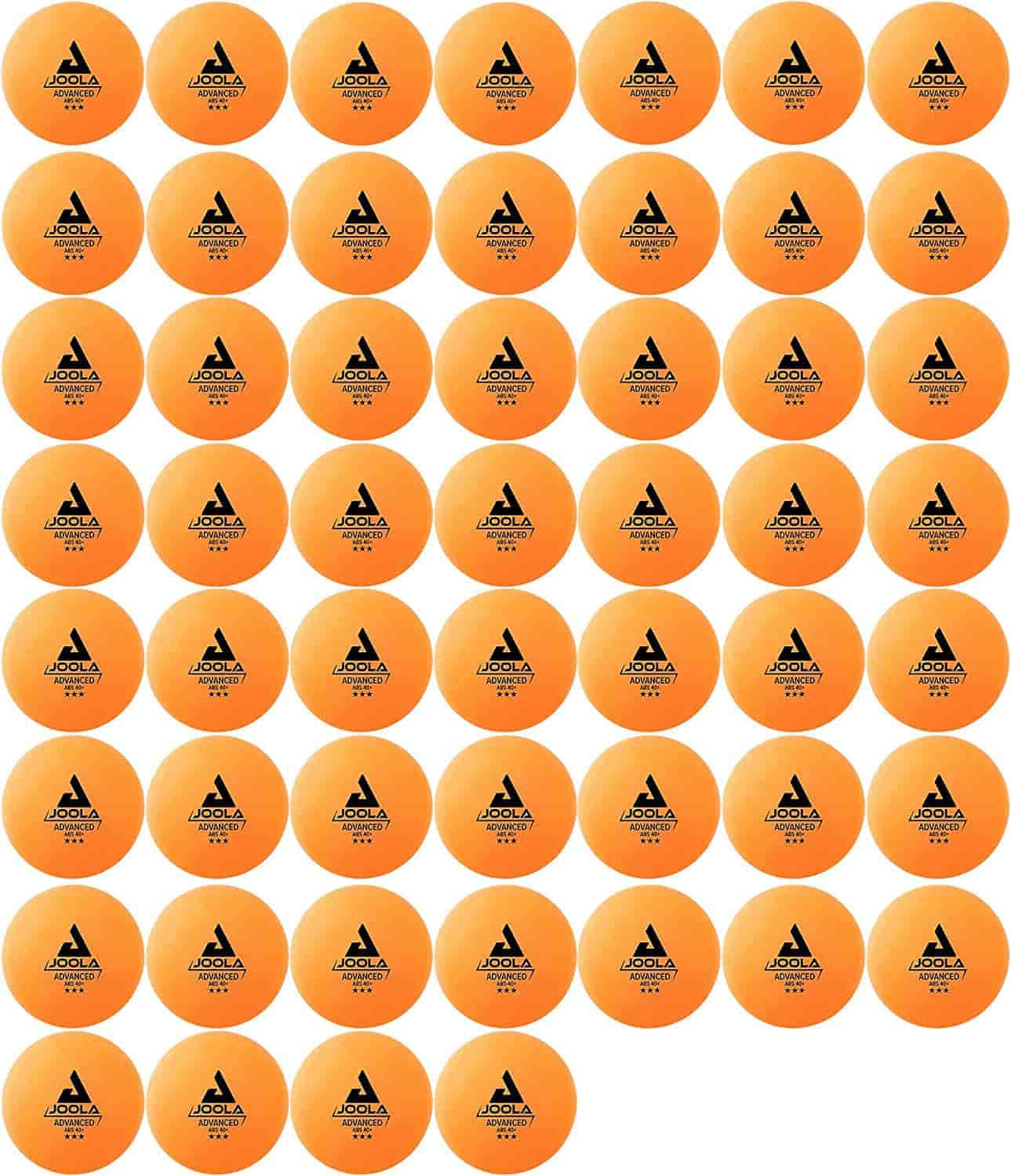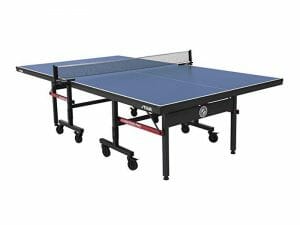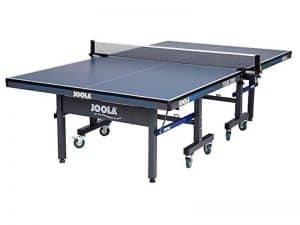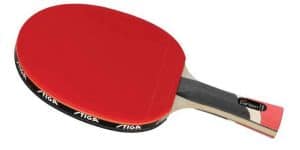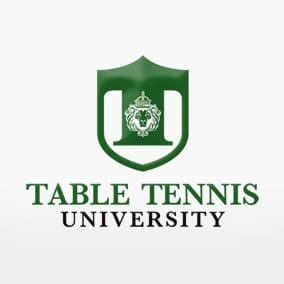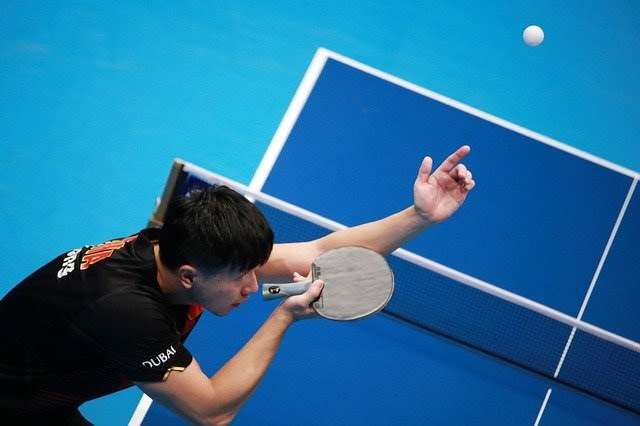The Best Ping Pong Balls: Reviews and Buying Guide for 2024
- Alex Horscroft
- Last updated
The best table tennis ball in 2024 is the Nittaku 3-Star Premium ball. It may be the most expensive, but the price is warranted. The ball feels hard, has a consistent bounce, and comes from top table tennis brand Nittaku, which has been leading ball popularity for some years now.
Based on my testing, the best ping pong balls in 2024 are:
- Nittaku 3-Star Premium ball — Best Overall
- DHS ABS D40+ 3-Star ball
- JOOLA Prime 3-Star ABS ball — Superb Value for Money
- Butterfly R40+ 3-Star ball
- Gambler P40+ 3-Star ball — Cheapest Match-Quality Ball
But these are just the top balls designed for competitive play. What about the rest? In this post, I cover the top training balls too, along with a guide to help you decide which balls are best for you.
At a Glance: Best Table Tennis Balls
| Rank | Image | Name | Type | Buy |
|---|---|---|---|---|
| 1 |  | Nittaku Premium 40+ 3 Star | Competition | CURRENT PRICE |
| 2 |  | DHS D40+3-Star Balls | Competition | CURRENT PRICE |
| 3 |  | JOOLA 3-Star Training Balls | Training | CURRENT PRICE |
| 4 |  | JOOLA Prime 3-Star ABS | Competition | CURRENT PRICE |
| 5 |  | Butterfly R40+ 3 Star | Competition | CURRENT PRICE |
| 6 |  | Gambler P40+ 3-Star Balls | Competition | CURRENT PRICE |
| 7 |  | Nittaku 3 Star Nexcel 40+ Balls | Competition | CURRENT PRICE |
| 8 |  | PRO SPIN 3-Star Balls | Training | CURRENT PRICE |
| 9 |  | MAPOL 40+ 3 Star | Training | CURRENT PRICE |
| 10 |  | KEVENZ 40+ 3 Star | Training | CURRENT PRICE |
Best Ping Pong Ball for Competitions
Specifications:
- Classification — 3-star
- Material — Plastic
- Color — White
- ITTF approved? — Yes
Nittaku Premium 40+ balls have consistently topped ping pong ball ratings from the table tennis community since before the introduction of plastic balls in 2014. They’re made in Japan, are ITTF-approved, very durable, and have a great reputation for their roundness and consistent bounce.
I notice a significant difference when I play with these balls, as they’re more accurate and less wobbly than cheap balls.
The only downside is that they are pretty expensive, but if you’re looking for the most professional ping pong ball you can get then most will agree the Nittaku 3 Star Premium ball is the one you want.
Specifications:
- Classification — 3-star
- Material — Plastic
- Color — Orange and white
- ITTF approved? — Yes
DHS ABS D40+ are the most common table tennis balls used at international events. They were used as the official ping pong ball for the World Championships for four years running from 2017 to 2020.
I’ve always enjoyed using DHS balls and found them to be very consistent. They were even a staple in my racket case back when celluloid balls were the only ones around. There is no doubt in my mind they are among the best balls you can buy, and as they are marginally cheaper than the Nittaku 3-Star Premium 40+, it’s easy to make the argument that they are the best balls overall.
#3 JOOLA Prime 3-Star ABS Balls (Pack of 6) — Superb Value for Money
Specifications:
- Classification — 3-star
- Material — Plastic
- Color — White
- ITTF approved? — Yes
These JOOLA Prime 3-Star ABS Balls have excellent thickness, even hardness, and consequently, greater durability. As you’d expect they are ITTF-approved and are a good option if you’re looking for a cost-effective premium competition ball. You can, however, go quite a bit cheaper and still get a 3-star ball, but the manufacturer likely won’t have the acclaim of JOOLA.
#4 Butterfly R40+ 3-Star Balls (Pack of 3/6/12)
Specifications:
- Classification — 3-star
- Material — Plastic
- Color — White
- ITTF approved? — Yes
The Butterfly 3-star R40+ marks the third generation of Butterfly’s plastic 3-star balls. Made in China, they undergo strict testing to ensure they are viable for the highest levels of play. Butterfly states that they are also more durable than previous versions, which is a strong selling point given how plastic balls can crack when you edge the ball during looping.
This ball was officially used for the 2021 World Championships — you can’t get any more prestigious than that.
#5 Gambler P40+ 3-Star Balls (Pack of 6) — Cheapest Match-Quality Ball

Specifications:
- Classification — 3-star
- Material — Plastic
- Color — White
- ITTF approved? — Yes
If you’re looking for a low-cost ITTF-approved 3-star ball then the Gambler P40+ could be the perfect option. At just $0.75 per ball, they are less than half the cost of the DHS D40+ ball yet they are of similar quality. As a result, I fully recommend them!
#6 Nittaku 3-Star Nexcel 40+ (Pack of 12)
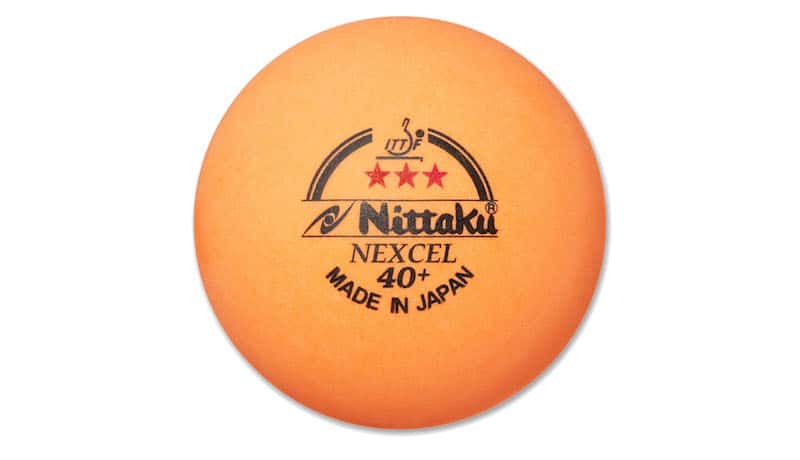
Specifications:
- Classification — 3-star
- Material — Plastic
- Color — Orange and white
- ITTF approved? — Yes
If you prefer orange balls to white ones then the Nittaku 3-star Nexcel 40+ balls are one of the best I’ve found. They’re very similar to the Nittaku 3 Star Premium balls as they’re also made in Japan and have a very consistent bounce. They are the first ITTF-approved orange balls and some players much prefer them over white balls as they’re a lot easier to see.
Read More: 19 Ping Pong Gifts That Players Will Love!
#1 JOOLA 3-Star Training Balls (Pack of 60/120)
Specifications:
- Classification — 3-star
- Material — Plastic
- Color — Orange
- ITTF approved? — No
If you’re after cheap training balls from a reputable table tennis name, you need look no further than the JOOLA 3-star training ball bundle. They are remarkably cheap and come in sets of either 60 or 120. The more you buy, the greater your savings! I like the fact that they are available in orange as there just isn’t enough orange ball availability these days.
While these balls meet ITTF guidelines, they are not officially approved. Therefore they are best reserved for training, your opponents might kick up a fuss if you use them in a local league setting, for instance.
#2 PRO SPIN 3-Star Balls (Pack of 12/24/60)
Specifications:
- Classification — 3-star
- Material — Plastic
- Color — Orange
- ITTF approved? — No
These balls from PRO SPIN are a good option for those looking for a step up from the 1 and 2-star training balls, but aren’t willing to pay the higher prices of the competition balls mentioned above. The quality isn’t quite as good as some of the other brands but you’ll get a better ball than most produced by non-table tennis specialists.
#3 MAPOL 3-Star Balls (Pack of 50)
Specifications:
- Classification — 3-star
- Material — Plastic
- Color — White
- ITTF approved? — No
If you want to buy some good ping pong balls in bulk for training or perhaps for use in a robot then these balls from Mapol might be a good option. They’ve not got the quality of a competition standard ball but considering the price, they’re pretty good value.
#4 Kevenz 3-Star Balls (Pack of 18/60) — Beginner’s Pick
Specifications:
- Classification — 3-star
- Material — Plastic
- Color — White and orange
- ITTF approved? — No
Another option for bulk buying table tennis balls is this bundle from Kevenz. You get 60 balls for less than the cost of one pack of premium competition balls. Pretty good if you ask me!
Ping Pong Ball Buying Guide
What things do you need to look for in the best table tennis ball? Below I’ll cover everything you need to know when looking to buy some new balls.
Ping Pong Ball Star Ratings: What Do They Mean?
Table tennis balls are given a number of stars from 1 to 3. Balls with 3 stars are of the best quality ping pong balls and are the most durable, while 1-star balls will break or lose their shape quicker. Novelty balls, toy balls, beer pong balls, and table tennis balls intended for children often don’t have any stars at all.
It’s important to know that these star ratings are not official or standardized. Each manufacturer assigns its own star ratings, so stars aren’t an independent measure of quality. An ITTF-approved stamp is a much better sign of a good ball. These have gone through rigorous tests and meet official ITTF regulations for tournament play. That being said 1 and 2-star balls, are usually much lower in quality than 3-star balls. They are best used for training sessions. Finally, balls without a star rating have no quality assurance, are wildly inconsistent, and are much more likely to get damaged.
ITTF Requirements for Table Tennis Balls
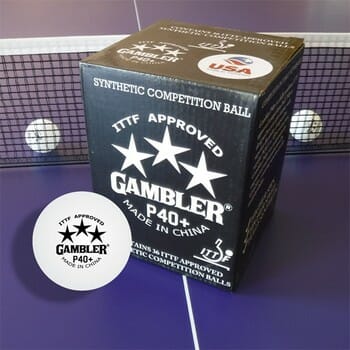
The ITTF has very strict requirements for table tennis balls with small allowances for variation during manufacturing. Competition table tennis balls must conform to these standards:
- The ball should be 40 mm in diameter
- The ball should weigh 2.7 grams
- Table tennis balls must be round
- They must not veer
- They must have a consistent bounce
- They must have a uniform hardness
- They must be of the correct thickness
Popular Ping Pong Ball Brands
Here are some of the top brands for table tennis balls, in no particular order:
Nittaku
Based in Japan, Nittaku has been making table tennis equipment since 1920. Many consider their high-quality ping pong balls to be some of the best in the world, and they have supplied competition balls for 13 World Championships, 3 Olympic Games, and 7 years of European Championships.
JOOLA
JOOLA is based in Germany and is one of the brands responsible for the first table tennis tables in the early 1950s. In 2018, American company Sport Squad Inc. acquired them. JOOLA table tennis balls draw consistently high praise from experts and amateurs alike.
DHS
DHS stands for “Double Happiness Shanghai,” and they are one of the largest manufacturers of table tennis balls in the world. Founded in 1959, the company was the official table tennis ball of the 2008, 2012, and 2014 World Championships.
Butterfly
Another Japanese brand that’s found in every lineup of top table tennis manufacturers is Butterfly. While only one of their balls made my list, they make several of the top-rated ping pong balls on the market.
How Ping Pong Ball Size Has Changed Over Time

Table tennis was invented in the late 1800s in Victorian England (read more about the history of table tennis here). The first ping pong balls were made out of rubber and cork but some improvised and even played with golf balls or balls of string.
In 1901, Englishman James Gibb was traveling in the United States and discovered some lightweight celluloid balls that he thought would be perfect for playing ping pong. In 1926, the International Table Tennis Federation (ITTF) formed, and competition table tennis balls were standardized as being 38 mm in diameter and made of celluloid.
Over time, advances in rackets made the game faster and faster to play. For the 2000 Olympic Games in Sydney, the ITTF increased the size of the ball from 38 mm to 40 mm. The intention here was to make the ball easier to see for television cameras and slow down gameplay to make the game more entertaining for spectators. You can easily identify these balls by their labeling which specifies 40 mm.
Then in 2014, the ITTF changed table tennis ball material from celluloid to non-flammable plastic. As a result, the balls became slightly larger in diameter than the old celluloid balls which is why you’ll see them labeled as 40+. To learn more, read our post What Are Ping Pong Balls Made Of?
Conclusion
There are many different types of ping pong balls to choose from and what you need depends on your ability and goals. If you’re playing in tournaments and competitions you’ll want to practice with the best ping pong balls. In this case, I recommend the Nittaku 3-Star Premium 40+. It really is a cracking ball (no pun intended) and is widely considered the best among players. The only issue with it is the cost.
If you would rather save money but still play with a high-quality 3-star ball, I recommend the JOOLA Prime 3-Star ball instead. It is still a great ball and isn’t wildly different from Nittaku’s. I also strongly advise you pick up some training balls to save your wallet. Buy one box of these and you won’t have to think about table tennis balls again for a long time, JOOLA 3-Star Training balls are my favorite in this category.
Enjoy this post? You can learn everything else there is to know about ping pong balls here.
Ping Pong Ball Frequently Asked Questions
How Do I Keep My Ping Pong Balls in the Best Condition?
Are There 5-Star Ping Pong Balls?
There are no 5-star ping pong balls. The classification system for table tennis balls only goes as high as 3 stars. Any higher is a marketing ploy to try and fool buyers into thinking their balls are higher quality than the rest. None of these balls are ITTF-approved and are probably best avoided for such dodgy tactics.
What Does the 40+ Mean on Ping Pong Balls?
When the balls changed material in 2014 from celluloid to plastic, the balls increased in width higher than 40 mm, but it was by less than 1 mm. To easily distinguish the old from the new, the new balls are marketed as 40+.
What Is the Difference Between Orange and White Ping Pong Balls?
There is no difference besides the color. Orange balls are useful as they are far more visible. Many of us play in sports halls with light backgrounds. As such, it’s very easy to lose a white ball during fast gameplay.
What Is the Difference Between 1-Star and 3-Star Ping Pong Balls?
3-star ping pong balls have passed much stricter tests so they are of the highest quality. 1-star balls have a less consistent bounce and are more likely to veer. Many 1-star balls also feel a lot lighter than 3-star balls.
What Ping Pong Balls Do They Use in the Olympics?
Double Happiness supplied both of the last Olympics: Rio 2016 and Tokyo 2020.
How Often Should I Change Table Tennis Balls?
You only need to change table tennis balls when you notice a crack has formed. Sometimes you can tell through feeling when you’re playing, but most of the time you’ll hear that the bounce sounds different.
Read More: The 10 Best Ping Pong Paddles: Reviews And Buying Guide
Freelance writer. Table tennis enthusiast. Lover of all things online. When I’m not working on my loop game I’m probably binge-watching some fantasy show.
-
Alex Horscrofthttps://pingpongruler.com/author/alex-horscroft/
-
Alex Horscrofthttps://pingpongruler.com/author/alex-horscroft/
-
Alex Horscrofthttps://pingpongruler.com/author/alex-horscroft/
-
Alex Horscrofthttps://pingpongruler.com/author/alex-horscroft/
Popular Products
Join our email list for exclusive reviews & the latest Ping Pong News
Sign up to our newsletter and stay up-to-date with the latest news in the ping pong world, and be the first to read our new product reviews. We promise, no spam


